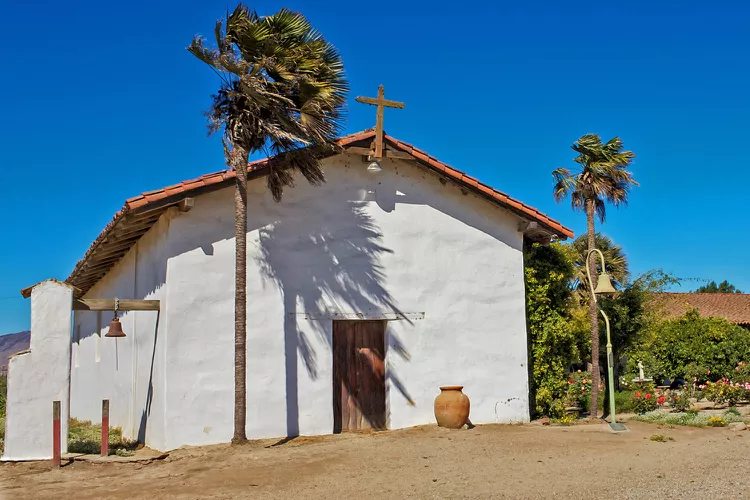Summary
Soledad Mission was the thirteenth mission built in California, founded on October 9, 1791, by Father Fermin Lasuen. It is known as Nuestra Senora de la Soledad, meaning “the Solitude of Most Holy Mary, Our Lady.”
Interesting Facts about Soledad Mission
Spanish Governor Arrillaga died at Soledad Mission in 1814. This mission was established so that priests could break their journey between San Antonio de Padua and Carmel. Over its 44-year history, more than 30 priests served at this location.
History of Soledad Mission: 1791 to Present Day
Soledad Mission was established on October 9, 1791, and was dedicated to “the Solitude of Most Holy Mary, Our Lady.” The name derives from the remote location and an expression used by the native Esselen Indians that sounded like “soledad,” the Spanish word for solitude.
Although it was located in a hot, windy, and treeless valley, the Soledad Mission provided a critical resting point along the 100-mile route connecting San Antonio de Padua in the south and Carmel in the north.
Where Is Soledad Mission Located?
Soledad Mission
36641 Fort Romie Road
Soledad, CA
Mission Website and current hours
Early Years of the Soledad Mission
Initially, Mission Soledad struggled due to harsh weather conditions, which included hot summers and freezing winters. The shortage of local Indigenous inhabitants further hampered its early growth.
The first two priests, Father Marino Rubi and Father Bartolome Gili, contributed to the challenges with their complaints and reluctance to stay. Father Rubi departed in 1793, followed by Father Gili a year later.
However, Father Florencio Ibanez arrived in 1803, marking the beginning of consistent leadership. He remained for fifteen years, instituting an irrigation system and cultivating crops and livestock. Despite the challenges presented by an epidemic in 1802, the population surged to 727 by 1805, with 688 of them being neophytes.
Sadly, the mission’s population dropped to 598 by 1810. In a twist of fate, California’s first Spanish Governor visited Soledad Mission in 1814, where he passed away and was buried in the old church when Father Ibanez died four years later.
Soledad Mission in the 1820s -1830s
After Father Ibanez’s death, Father Vicente Sarria, a former President of the California Missions, took over the mission. In 1827, an inventory reported 5,400 sheep, 4,000 cattle, and 800 horses.
Unfortunately, multiple floods in 1824, 1828, and 1832 devastated the church and chapel, which were never rebuilt. Father Sarria continued to serve despite the hardships, ultimately succumbing to starvation, and was buried at Mission San Antonio.
During its operation, the priests performed 2,000 baptisms and 700 marriages.
Secularization at Soledad Mission
The secularization of Soledad Mission in 1834 revealed its assets: a 5,000-vine vineyard, three ranchos, 3,246 cattle, 2,400 sheep, and 32 horses. However, it owed more than it possessed, lacking a roof because it was sold off to settle debts with the Mexican government. By 1839, only 78 neophytes, 45 cattle, 586 sheep, and 25 horses remained.
In 1845, Governor Pio Pico sold the site for $800, but the structure deteriorated over the years due to exposure to the elements and neglect.
Soledad Mission in the 20th Century
Reconstruction efforts commenced in 1954, leading to the rebuilding of the chapel and a few adjoining rooms.
Soledad Mission Layout, Floor Plan, Buildings, and Grounds
Initially, the Soledad Mission comprised brush shelters due to material scarcity; the first permanent structure, an adobe chapel, took six years to complete. Flooding was a perennial issue, as the location near the Salinas and Arroyo Seco Rivers often resulted in disastrous inundations.
Recurring floods in 1824, 1828, and 1832 led to the destruction of both the church and chapel, which were never rebuilt. The remaining buildings fell into disrepair after their roof was sold in 1835 to pay debts, languishing uneventfully for the next 90 years until reconstruction began in 1954.
The original bell, sent from Mexico in 1794, still hangs outside the chapel today.
Soledad Mission Brand

The image above showcases the cattle brand of Soledad Mission, derived from examples displayed at Mission San Francisco Solano in Sonoma and Mission San Antonio.





